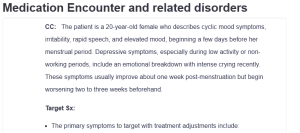Medication Encounter and related disorders
| S
|
CC: The patient is a 20-year-old female who describes cyclic mood symptoms, irritability, rapid speech, and elevated mood, beginning a few days before her menstrual period. Depressive symptoms, especially during low activity or non-working periods, include an emotional breakdown with intense crying recently. These symptoms usually improve about one week post-menstruation but begin worsening two to three weeks beforehand.
Target Sx:
o Significant mood swings linked to hormonal changes o Irritability and mood elevation before menstruation o Depression occurring primarily during non-working periods o Anxiety sleep disturbances are a cyclic course of exacerbation and relief related to her menstrual cycle symptoms that could be treated pharmacologically and non-pharmacologically, along with medication adjustment in an attempt to get overall mood stability and quality-of-life improvement. Medication Considerations:
Lamotrigine is generally well-tolerated and effective for reducing bipolar-related mood swings. Remeron provides support for sleep disturbances commonly associated with depressive episodes. Prozac, a selective serotonin reuptake inhibitor (SSRI), is effective for mood regulation and may be particularly beneficial for her premenstrual dysphoric disorder symptoms with targeted dosing adjustments. Propranolol effectively manages situational anxiety without significant cardiovascular concerns, as evidenced by her stable vitals (American Psychiatric Association, 2022). |
| O | Vitals:
These are signs of tachycardia and hypertension that may require follow-up. Usually, anxiety is well-controlled by Propranolol; this observation may signal the need to reevaluate the dosage or additional interventions for better stabilization of cardiovascular functions in the current treatment. Rating Scale(s):
Using both scales will allow for tracking changes over time, establishing a symptom baseline, and providing concrete measures of treatment efficacy. Previous Test done on the previous visit: o PHQ-9: The score is 22/27, indicating severe depression. Thus, close observation and potential adjustment of the antidepressant dose are indicated. o The MDQ, or Mood Disorder Questionnaire, has positive responses that confirm the bipolar trends and hence justify further use of mood stabilizers, adding an antipsychotic for better mood regulation. Labs:
Regular lab tests will ensure that her medications are not contributing to adverse effects, allowing for prompt adjustment if necessary. ROS:
This review reflects the broad impact of her symptoms across multiple systems, confirming that mood symptoms are cyclical and linked to hormonal changes. |
| A | The Previous diagnosis and ICD-10 Code:
o Bipolar Disorder, Current Episode Depressed, Moderate (F31.64): This diagnosis represents her cyclic depressive and manic-like symptoms. The current depressive episode consists of low mood, irritability, and crying spells, especially during non-working periods (National Institute of Mental Health, 2024). Symptoms are considered to be moderate in that they interfere with daily activities but remain manageable. o Adjustment disorder with Anxiety (F43.12): This is regarding situational anxiety that might have been heightened through life events or stress. There is heightened anxiety at specific times, such as during the premenstrual phase of her menstrual cycle. o Insomnia Disorder (F51.05): Characterized by difficulty initiating or maintaining sleep, this sleep disorder may contribute to fatigue and emotional instability. The sleep disturbance is associated with mood disturbance and may be exacerbated during depressive or anxious states (Kaur et al., 2023). DSM-5 Dx with Specifiers and ICD-10 Code:
DSM-5 Rule-Out Dx and ICD-10 Code:
|
| P | 1st Medication Choice with Prescription Information, Side Effects, and Rationale:
For augmentation of mood stabilization with Lamotrigine, consider adding the antipsychotic Aripiprazole. It is one of the more common adjuncts to mood stabilizers in bipolar disorder and may offer additional symptomatic control of mania.
Initiate at 5 mg daily, titrating as necessary.
It is a sedative; it also induces restlessness and GI problems.
Aripiprazole can be continued, as it has a relatively good side effect profile and has a lower risk of metabolic side effects compared to the rest of the antipsychotics; thus, it is suitable for long-term management. 2nd Medication Choice with Prescription Information, Side Effects, and Rationale:
· Patient/Family Education
|
References
American Psychiatric Association. (2022). Diagnostic and Statistical Manual of Mental Disorders DSM-5. American Psychiatric Association.
Bauer, M., Glenn, T., Alda, M., Bauer, R., Grof, P., Marsh, W., Monteith, S., Munoz, R., Rasgon, N., Sagduyu, K., & Whybrow, P. C. (2019). Trajectories of adherence to mood stabilizers in patients with bipolar disorder. International Journal of Bipolar Disorders, 7(1). https://doi.org/10.1186/s40345-019-0154-z
Jain, A., & Mitra, P. (2023). Bipolar disorder. PubMed; StatPearls Publishing. https://www.ncbi.nlm.nih.gov/books/NBK558998/
Kaur, H., Spurling, B. C., & Bollu, P. C. (2023). Chronic Insomnia. PubMed; StatPearls Publishing. https://www.ncbi.nlm.nih.gov/books/NBK526136/
National Institute of Mental Health. (2024). Bipolar Disorder. National Institute of Mental Health. https://www.nimh.nih.gov/health/topics/bipolar-disorder
ORDER A PLAGIARISM-FREE PAPER HERE
We’ll write everything from scratch
Question 
Details
Select a patient from your clinical experience who has bipolar I, bipolar II, or a bipolar related disorder. The patient may be of any age. Set aside time during your practicum experience to interview the patient. Include all parameters listed on the Medication Encounter Template. Determine appropriate testing for this patient, interpret your findings, and compose an appropriate plan of care including recommended psychopharmacology, other behavioral approaches, and pertinent referrals/consults.
Use this Bipolar Patient
Age 20, female, Caucasian. Patient comes in the clinic to follow up with medications. During the interview patient reports her mood is better but she started being irritable few days before her periods start. She reports talking too much, fast, and elevated mood. She stated she is depressed when she does not have to work. She stated she had mental break down few months ago also and started crying. She said it is usually improved 1 week after her periods and worse 2 or 3 weeks before her periods.

Medication Encounter and related disorders
Medications:
Lamotrigine 100 mg
Remeron 7.5 mg for sleep
Prozac 40mg
Propranolol 10 mg for anxiety